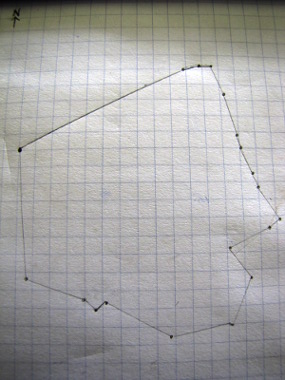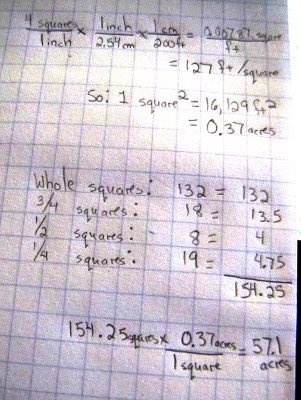
How to estimate acreage of a property
 Yesterday, I explained how
to map your property boundaries from a deed. I told you to use a
sheet of graph paper for your mapping, but didn't mention that the
purpose of the graph paper is to make it easy to measure the acreage of
your property.
Yesterday, I explained how
to map your property boundaries from a deed. I told you to use a
sheet of graph paper for your mapping, but didn't mention that the
purpose of the graph paper is to make it easy to measure the acreage of
your property.
Your first step is to
figure out how much land area one square equates to. My graph
paper has four squares per inch and the scale of my map is one
centimeter for every 200 feet, which means (using the math shown in the
second image) that each square is equal to 127 feet on each side.
The area of the square
is 127 feet times 127 feet, or 16,129 square feet. Since one acre
contains 43,560 square feet, one of my graph paper squares bounds 0.37
acres.
Now
for the fun part --- counting squares! First, count how many
squares are entirely contained in your property boundary, making a mark
 inside each one so you don't double count it. If you want to get
a very accurate estimate (and spend all day at this project), you can
then estimate the percent of each boundary square that's within your
property, but I simply divide partial squares up into three categories
--- those approximately 75% contained in the property, those half
contained in the property, and those 25% contained in the
property. I count how many squares fit in each of these
categories, putting a dot in each square once again as I count
it.
inside each one so you don't double count it. If you want to get
a very accurate estimate (and spend all day at this project), you can
then estimate the percent of each boundary square that's within your
property, but I simply divide partial squares up into three categories
--- those approximately 75% contained in the property, those half
contained in the property, and those 25% contained in the
property. I count how many squares fit in each of these
categories, putting a dot in each square once again as I count
it.
A little math shows that
my property consists of approximately 154.25 squares, or 57.1
acres. The deed listed the property as 57.72 acres, so it looks
like my mapping and math were pretty good!
You can use this same
technique to estimate the acreage of parts of your property from a topo map or aerial
photo. For example, do you want to know how big that cleared area
is? Just figure out the scale, trace the boundaries onto a sheet
of graph paper, and go to town. Or you could use Google
Planimeter....
Want more in-depth information? Browse through our books.
Or explore more posts by date or by subject.
About us: Anna Hess and Mark Hamilton spent over a decade living self-sufficiently in the mountains of Virginia before moving north to start over from scratch in the foothills of Ohio. They've experimented with permaculture, no-till gardening, trailersteading, home-based microbusinesses and much more, writing about their adventures in both blogs and books.
Want to be notified when new comments are posted on this page? Click on the RSS button after you add a comment to subscribe to the comment feed, or simply check the box beside "email replies to me" while writing your comment.

If you already have all the numbers in a spreadsheet, and you can calculate the coordinates of the points, then calculating the area of a closed polygon is relatively straightforward. Based on the numbers you published, I get 57.48 acres.
Maggie --- I enjoy it too.
Roland --- Funny to hear that the real acreage is midway between my estimate and the deed's estimate.
For those reading along at home, you can download Roland's spreadsheet, fill in your own data, and plot your boundaries and measure acreage the easy way! Thanks so much for sharing that, Roland!